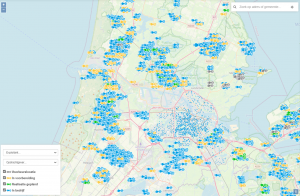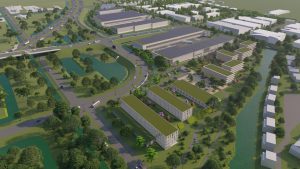City logistics: Can we charge the Metropolis?
In large parts of the Amsterdam Metropolitan Area, only zero-emission vehicles will be allowed to drive around. Working on a good charging infrastructure around logistics hubs, distribution centers and regional business parks is therefore crucial. At the seventh meetup about the Green Deal ZES, we saw what is already happening, but also what challenges still lie ahead. “Power is not the problem, capacity is.”
Shippers, transporters and logistics service providers are now being encouraged to switch to clean, electric transport vehicles. “We must therefore also invest in a regional approach for smart charging options,” says Richard Hoving, Lead Mobility at the Amsterdam Economic Board at the start of the meetup. “We can only handle this gigantic task if we work on it together.”
Megawatt charging
Robert van den Hoed knows the challenges like no other. He is chairman of the logistics working group of the National Agenda Charging Infrastructure , which, among other things, develops a knowledge and action agenda, conducts research, publishes tools and guidelines and stimulates national initiatives. The starting point? Ensuring that the logistics charging infrastructure does not hinder zero-emission logistics.
After all, much more power is needed to load delivery vans and, in the future, trucks. It is even being megawatt charging worked. “A tractor trailer sometimes also has to be able to load on the road and that is not possible at Fastned, so we need separate fast charging infrastructure for this,” says Van den Hoed. “And think of construction sites, for example. If we also want to start charging there, we need an early grid connection.”
Of the 1 million delivery and freight vehicles, only 0.6 percent is now electric and E-Laad NL expects that there will be around 40,000 electric delivery and freight vehicles in 2025 and 600,000 in 2035. Drivers for further growth are the zero-emission zones, but also the fact that more and more electric alternatives are becoming available. Van den Hoed: “The prices of batteries are also still falling sharply: the Total Cost of Ownership of electric delivery vans is now even more expensive, but that will not last long. And the same will soon apply to trucks.”
The logistics working group of the National Agenda Charging Infrastructure is organizing an event about this subject. Here you will find more information .
The regional charging needs in pictures
For Maarten Linnenkamp, program manager MRA-Electric is the biggest challenge to get a good picture of the charging requirement. How many companies need (fast) charging capacity? Should that be public or private charging capacity? “If we know this, we can match this with the grid management and make the right provisions on time. The capacity offered by grid operators is particularly worrying; we can’t just install charging stations everywhere.”
The basic principle of MRA-Elektrisch is that the region uses the available energy as efficiently as possible. “That is a huge task, also because all houses have to get rid of gas and that companies such as Tata Steel are also going to be more electric. At the same time, it should not be the case that if someone installs a fast charger now, he ensures that his neighbor will no longer be able to do so. That is why it is so important that we provide insight into everything on a clever map.”
Electricity is the new gold
According to Walther Ploos van Amstel, Lecturer City Logistics at the Amsterdam University of Applied Sciences, electricity is the new gold. At the same time, many people see the charging infrastructure as a chore. Smart market parties are responding to this by coming up with expensive solutions. His advice? Don’t let the caas — charging as a service — eat the bread and pay attention to your own charging profile.
Read Walther’s entire column here.
Logistics testing ground CLIC
CLIC can make an important contribution to our logistics loading challenge. CLIC stands for City Logistics Innovation Campus and is an area of 132,000 m2 along the A9 that will serve as a testing ground for energy in city logistics from the end of 2022. “We see CLIC as a city port, where flows of goods arrive that are transhipped there, which means that all kinds of other services are also needed,” says project manager Robert Kreeft.
Inventing, trying out and rolling out are central. Opportunities are being sought to vary the energy supply, for example with a buffer in the form of a wadi, a virtual power plant. “By using the capacity of cold stores and food preparation, for example, we can achieve a lower power demand,” says Kreeft. “Then we need a lower central connection and the grid operator therefore has to invest less. We also need data on departure and arrival times of vehicles. This way we know at what times and in which places we need to create buffers.”
An important principle of the experiments is that a business model will be created in which all participating parties benefit. Kreeft: “Only then can you create a win-win-win situation.”
In the waiting room
Pallas Agterberg, Challenge Officer at Alliander, takes us into the capacity issue. The power doesn’t go on, she explains. We produce more than enough ourselves and have a good connection with other countries. The big challenge is the capacity of our network. “There are quite a few congestion areas in the Metropolitan Region, which means that the waiting room is already full. In addition, we will need 3 to 4.5 times as much network in the coming years, so the waiting times will increase.”
Alliander is working on sharpening demand for the short and medium term and is looking for areas where there is still capacity. The company also wants to accelerate the realization of more loading capacity by shortening lead times and recruiting more technicians. The use of connections in a different way, for example with storage, is also being investigated.
Agterberg: “We can only work on this together. You’re not going to buy an expensive electric truck if you can’t charge. If no location is known, you will not start working with the charging infrastructure. So we have to look for breakthroughs if we don’t want to sit in that waiting room and wait.”
Existing business parks
What can we already do on the existing industrial estates? Hoving asks today’s speakers at the end of the meeting. According to Ploos van Amstel, existing business parks should mainly link with the owners of the buildings. “They often have several buildings in such an area and a plan for further development. So we have to get them to the table.” Linnenkamp of MRA-Elektrisch encourages to get a good picture of what is already there, what is possible and what is allowed in each area. “Sometimes we just have to start, just do it.” Van der Hoed refers to the bus sector, which has a good methodology for determining good logistics points.
“Today it became clear that new connections are needed,” Hoving concluded at the meeting. “The discussion is far from over and you ask we run does not exist. We must therefore continue to work together on the route to the zero-emission areas in 2025.”
On October 12 there will be a new meetup about the green deal ZES. In the meantime, would you like to know more about electric driving in city logistics? You will find a Quick Start on our Insights platform that helps you on your way.
23 June 2021
Read more about
Contact us
Want to keep up to date?
Get the best regional news and events (in Dutch) via the Board Update newsletter
Share this news
Want to keep informed?
Follow us daily on LinkedIn and sign up for the Board Update newsletter.
Read more
- On 14 and 15 October, board members of the Amsterdam Economic Board convened for ...
- Focusing more on women in health care innovation and research will have ...
- What is the Amsterdam Metropolitan Area’s position on critical raw materials? ...



